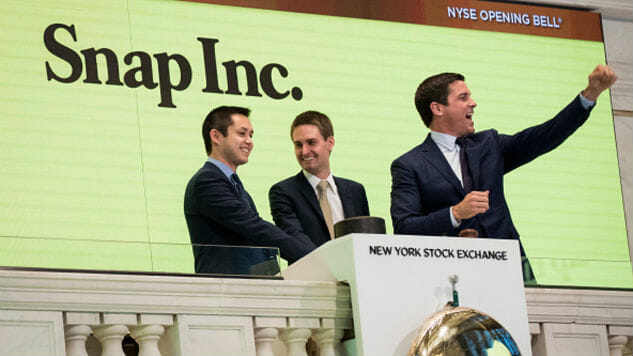Snap’s IPO Was a Success, but What They Do Next Is What Really Matters
Photos by Drew Angerer / Getty Images Tech Features Snap
The largest tech IPO since Facebook. That’s what all the headlines have been saying this week after Snap, the parent company of Snapchat, went public on the New York Stock Exchange.
By all accounts the IPO was a success, despite several concerns. Earlier in the week, Snap had priced the IPO at $17 per share but when trading commenced it opened at a generous $24 and ended the day at $24.48. The flotation raised $3.4 billion, valuing the company and image sharing app at around $28 billion, though investors have no voting rights.
Much had been made of the company’s valuation over the last few weeks after Snap published its S-1 filing, which laid out the state of the company ahead of the flotation. Original estimates between $20 billion and $25 billion were bandied around but at one point the valuation was believed to be as low at $19 billion in response to concerns over the app’s monetization plans. A lower valuation was seen as a more cautious route in case things didn’t exactly work out. Snap CEO Evan Spiegel and his co-founder Bobby Murphy, who both still own a considerable majority of shares, didn’t want to go the way of so many tech IPOs by over-promising.
Tech IPOs are famously rocky. Facebook’s IPO in 2012 was a pivotal moment for its generation of Silicon Valley darlings but it overstretched at first, pricing its shares at $42 and from there plummeted. It has of course rebounded several times over since then. Twitter on the other hand has been rustled many times since it went public in 2013 and now stands at less than half the value it was at the time of the IPO.
Snap’s eventual IPO has been the subject of speculation for years with investors and analysts picking apart its user growth and operating costs. While Thursday’s IPO was a winner, the follow-through is everything.
It is not out of the woods; far from it. Worries abound about how the company will execute its future money making strategies through advertising and partnerships and how it will continue to grow its user base.

Latest figures show that the app has over 150 million active daily users but this growth was slowing down after a period of acceleration. Just ask Twitter how slow user growth can spook investors. Snapchat on the other hand has one key tool in its belt, it has a large user base of teenagers—a user market that Facebook and Twitter wish it could tap into in the same way.
During its investor roadshow over the last few weeks, Snapchat was tasked with convincing investors that it would not endure the same fate as Twitter and that it has plenty of new tactics ahead for monetization.
But after the company filed its S-1 papers, there was one very telling statement that you’ll find on page 19: “We have incurred operating losses in the past, expect to incur operating losses in the future, and may never achieve or maintain profitability.”
One of Snap’s biggest operating costs comes from hosting. It has contracts with Google and Amazon. Here’s a little perspective: Snap raised $3.4 billion this week from the IPO and its hosting contract with Google Cloud is worth $2 billion while its AWS contract is $1 billion. Running Snapchat is an expensive task.
The other bugbear is competition. Facebook has been on Snapchat’s heels for years. It famously offered $3 billion for the messaging app in 2013, which it turned down. On the roadshow, investors raised questions over Facebook-owned Instagram and the launch of its Stories feature, a similar ephemeral picture and video sharing function.
Snapchat has a lot of competition from all messaging and social apps but Instagram Stories is as direct a competitor it can get. Interestingly, the latest slowdown in Snapchat activity happened around the same time as Stories’ launch. Initially this can be credited to users trying out the newest toy but it can’t be ignored either.
Facebook with its massive resources will be a constant thorn in Snapchat’s side. But it has attempted to ape Snapchat on several occasions and still has not reached the same traction. Snapchat has proven it can innovate in the past, ahead of the bigger players, and it will need to continue doing this.

However it will need to show off some new ideas fast and Spiegel and co. aren’t keen on outside influences. They are maintaining a tight grip on the company by only selling non-voting shares in Snap. Investors won’t have a say in how the company operates, which for some could be a deal breaker. Spiegel is obviously confident in the company’s ability to turnaround its burn rate on its own but will others feel the same?
Once again, in its S-1, Snap said the “loss of one or more of our key personnel, or our failure to attract and retain other highly qualified personnel in the future, could seriously harm our business”.
The filing went on to say that if Murphy or Spiegel left the company for any reason, “it is unlikely that the other co-founder would be able to fulfill the responsibilities of the departing co-founder” and finding a swift replacement would be unlikely as well. In other words: both of us or neither of us.
Nevertheless, the shares were ten times oversubscribed. It places Snapchat in a strange predicament. It quite clearly has a lot of challenges but a lot of investors still want a piece. Either way, Evan Spiegel and Bobby Murphy are billionaires now—and while that’s true, their next move will be everything.